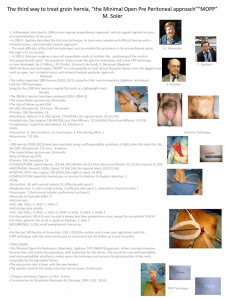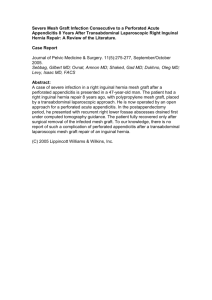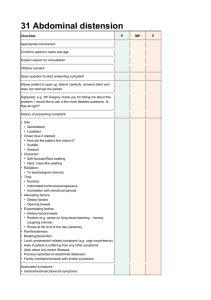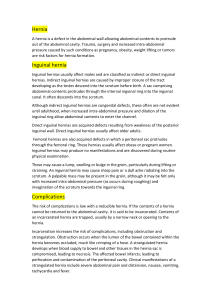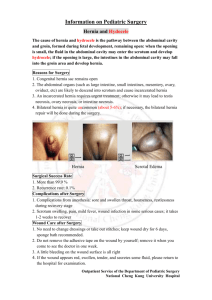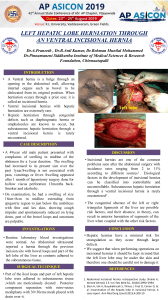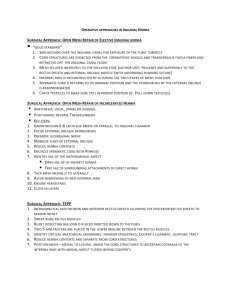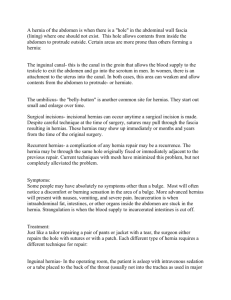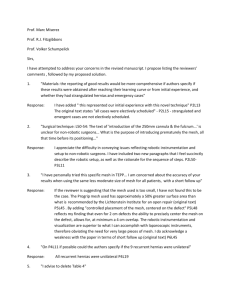NEW REAL-TIME INTERACTIVE CARDIAC MRI
advertisement
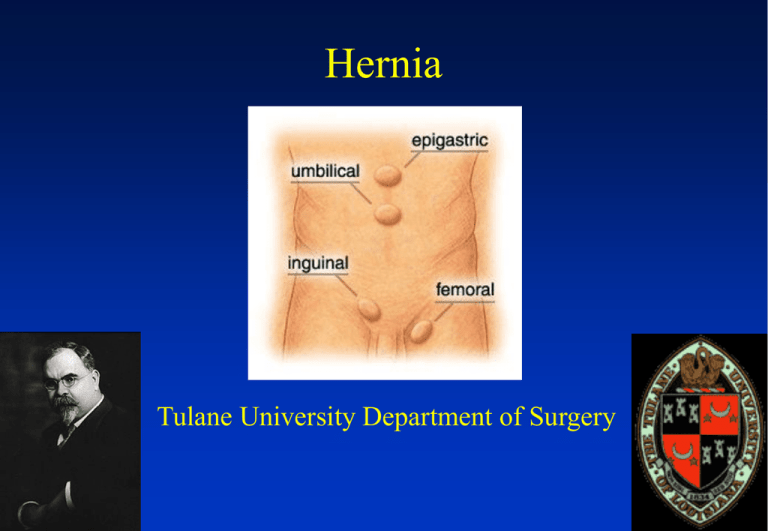
Hernia Tulane University Department of Surgery What is a Hernia? • Congenital or Acquired defect in the abdominal wall • Herniorrhaphy is one of the most commonly performed operations in all of surgery • Incidence ~ 1-5% Physical Exam Characteristics • Reducible: hernia returns to anatomical location • Incarcerated: fixed hernia +/- intestinal obstruction • Strangulated: s/s of ischemia and obstruction Abdominal Wall Anatomy 9 Layers • • • • • • • • • Skin Subcutaneous fat Camper’s fascia Scarpa’s fascia External Oblique Internal Oblique Transversus Abdominus Transversalis fascia Peritoneum Types 1. Inguinal 2. Femoral 3. Umbilical 4. Epigastric 5. Sliding 6. Littre’s 7. Internal 8. Obturator 9. Petit’s 10. Gryngelt’s 11. Coopers 12. Pantaloon 13. Richters 14. Incisional 15. Ventral 16. Hiatal 17. Parastomal 18. Etc. What is the most common Type? Types 1. Inguinal 2. Femoral 3. Umbilical 4. Epigastric 5. Sliding 6. Littre’s 7. Internal 8. Obturator 9. Petit’s 10. Gryngelt’s 11. Lumbar 12. Pantaloon 13. Richters 14. Incisional 15. Ventral 16. Hiatal 17. Parastomal 18. Etc. What is the most common Type? Differential Diagnosis (Inguinal Hernias) • • • • • • Lymphadenopathy Varicocele Undescended testicle Hematoma/Pseudoaneursym Sarcoma Lipoma Contents of Spermatic Cord • • • • Vas deferans Spermatic vessels Genital branch of gentiofemoral nerve Cremasteric vessels Inguinal Repairs • • • • • Marcy Bassini McVay Shouldice LICHTENSTEIN – Tension Free Acquired Causes • • • • • Increased abdominal pressure Obesity Chronic cough Ascites Pregnancy Hesselbach’s Triangle Indirect (50%) >> Direct (25%) Indirect Hernia Operative Repair—Mesh, Mesh, Mesh Incisional Hernias • Up to 11% of pts with previous laparotomy will develop hernia • Previous hernia is a risk for development of future hernia • Chances of successful closure decrease with each successive repair attempt Incisional Hernia Repairs Repair Recurrence 3yr Recurrence 10yr Complication Suture 42% 63% 8% Mesh 24% 32% 17% Abdominal Wall Reconstruction Paradigm for Repairs 1900- Silver Filigree Mesh Stainless Steel Cloth Shift 1 1940- Tantalum Mesh (metal) 1944- Nylon Mesh 1958- Marlex (Polyethylene) 1962- Prolene (Polypropylene) 1984- Mersilene (Polyester) Shift 2 1985- Component Separation Shift 3 - Bioprosthetics Component Separation • Defined anatomic planes and range of advancement of rectus-internal/transversus muscle block Alloderm • Acellular Human Dermis • Epidermis and all cellular compenents are removed • Initially used in burn patients as a scaffolding for STSG • Minimal inflammatory response cost $/cm2 30 26.38 25 20 15 10 5 0 8.33 4.8 3.4 S u rgi s i s 4.29 0.65 Pe rm acol PTFE Du al Prol e n e Al l ode rm Vi cryl Conclusion • Hernias REQUIRE SURGERY to prevent further complications (intestinal obstruction and infarction) – If reducible----elective – If incacerated----semi-elective – If strangulated----emergent Questions? According to the National Center for Health Statistics, approximately five million Americans have an abdominal hernia, but only a fraction of those seek treatment. Hernias do not go away and, if left untreated, may worsen over time, causing complications.


